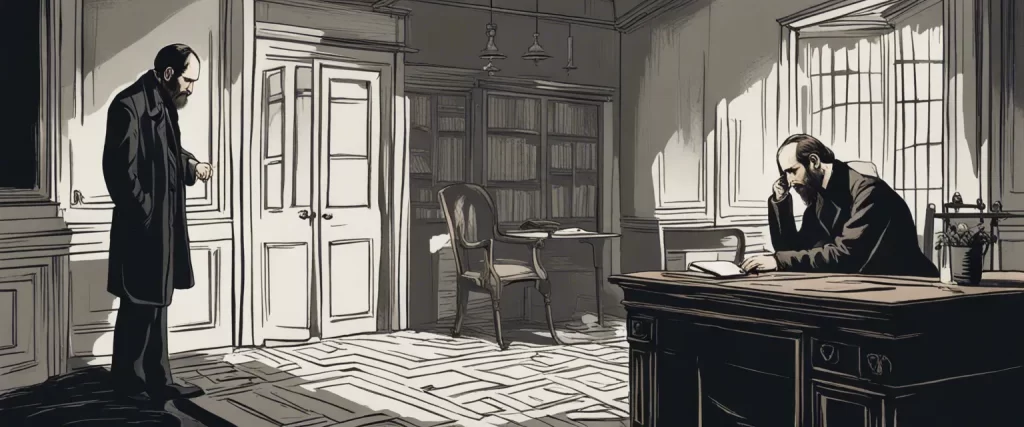Exploring the Timeless Genius of Crime And Punishment: An Unforgettable Fiction Classic by Fyodor Dostoevsky

In the realm of timeless literary masterpieces, few novels have captivated readers with their profound exploration of the human psyche quite like Fyodor Dostoevsky’s Crime and Punishment. Published in 1866, this fiction classic has not only withstood the test of time but has also continued to provoke thought and ignite intense discussions. Through its intricate plot and complex characters, Dostoevsky delves deep into the themes of guilt, morality, and redemption, leaving an indelible mark on the world of literature. Brace yourself for a journey into the depths of the human soul as we examine the enduring brilliance of Crime and Punishment, a work that stands as a timeless testament to the power of fiction.
What is Fiction Classic
Fiction classic refers to a work of fiction that has stood the test of time and is considered to be one of the greatest or most important works in the genre. These are often regarded as seminal texts that have influenced subsequent works and continue to be read and studied by readers across generations. Examples of fiction classics include novels like “Pride and Prejudice” by Jane Austen, “To Kill a Mockingbird” by Harper Lee, “1984” by George Orwell, and “Moby-Dick” by Herman Melville.
Why is Fiction Classic Important to Us
Fiction, especially classic fiction, is important to us for several reasons:
1. Cultural preservation: Classic fiction provides a glimpse into the thoughts, values, and traditions of the past. It helps us understand the historical context and cultural background of a particular period. By studying classic fiction, we can appreciate the ideas and experiences of previous generations, preserving and celebrating our cultural heritage.
2. Literature as art: Fiction, especially classic fiction, is often considered a form of art. It showcases the creativity, imagination, and craftsmanship of writers. It allows readers to engage with storytelling as an art form, appreciating the beauty and power of language, narrative structure, and character development.
3. Exploration of human experiences: Classic fiction offers insights into various aspects of human experiences across different time periods and societies. By delving into the lives and perspectives of fictional characters, we can develop empathy, understanding, and introspection. It helps us reflect on our own experiences, relationships, emotions, and moral dilemmas.
4. Influence on contemporary literature: Classic fiction often serves as a foundation for contemporary literature. Many modern writers draw inspiration from and pay homage to classic works. By understanding the themes, techniques, and innovations of classic fiction, we can better appreciate and analyze contemporary literary works as they build upon, redefine, or challenge those traditions.
5. Critical thinking and analysis: Reading classic fiction encourages critical thinking and analysis. It allows readers to challenge their preconceptions, explore different viewpoints, and engage in literary interpretation. By analyzing classic literature, we develop literary and analytical skills that can be applied in various aspects of life, such as assessing arguments, understanding symbolism, and appreciating complex narratives.
6. Universal themes and timeless wisdom: Classic fiction often explores universal themes that transcend time and place, such as love, loss, identity, and the human condition. These themes resonate with readers across generations as they offer insights and wisdom into life’s challenges and dilemmas. Classic fiction serves as a source of guidance, inspiration, and wisdom that can be relevant and meaningful to us today.
Unlocking Fiction Classic from Fyodor Dostoevsky

Fyodor Dostoevsky Introduction
“Crime and Punishment” is a psychological novel written by Fyodor Dostoevsky. The story revolves around Rodion Raskolnikov, a destitute ex-student living in St. Petersburg. Raskolnikov becomes consumed with an idea that some individuals are extraordinary and can thus transcend conventional moral laws to commit extraordinary acts. He decides to test this theory by murdering an old pawnbroker whom he believes to be useless to society.
However, immediately after the crime, Raskolnikov experiences intense guilt and anxiety, driven by the investigation that unfolds and his deteriorating mental state. He becomes embroiled in a cat-and-mouse game with police detective Porfiry Petrovich, who suspects his guilt but lacks sufficient evidence to prove it. Meanwhile, Raskolnikov meets Sonia, a religious young woman forced into prostitution to support her family. Sonia acts as his moral compass and he slowly develops a bond with her, ultimately leading to his confession.
Throughout the novel, Dostoevsky delves into the complex psychology and moral struggles of its characters, exploring themes of guilt, redemption, and the consequences of one’s actions. Raskolnikov’s inner turmoil and moral transformation serve as a critique of nihilism and an exploration of the human capacity for evil and the potential for redemption.
Fiction Classic Methods
In the novel Crime and Punishment by Fyodor Dostoevsky, several Fiction Classic methods are employed. Here are a few examples:
1. Psychological Realism: Dostoevsky delves deep into the psychological states of his characters, providing detailed insights into their thoughts, emotions, and motivations. This approach adds complexity and depth to the characters, making them relatable and believable to readers.
2. Social Criticism: The novel explores the social conditions and moral dilemmas faced by individuals in 19th-century Russia. Dostoevsky criticizes the oppressive and poverty-stricken society, highlighting the consequences of such conditions on individual behavior and morality.
3. Moral Ambiguity: The characters in Crime and Punishment are complex and morally ambiguous, blurring the lines between right and wrong. The protagonist, Raskolnikov, commits a murder to prove his “extraordinary” status and his right to act beyond morality. Dostoevsky challenges traditional notions of morality and examines the consequences of moral transgressions.
4. Multiple Narrative Perspectives: Dostoevsky employs different narrative perspectives throughout the novel. He offers an omniscient perspective, allowing readers access to the inner thoughts of multiple characters. This technique presents different viewpoints and adds layers of complexity to the story.
5. Symbolism: The novel includes various symbolic elements to convey deeper meanings. For example, the yellow wallpaper in the apartment where the murder takes place can symbolize mental degradation, confinement, and the decay of morality. Symbolism is used to enhance the thematic depth of the novel.
6. Existential Themes: Dostoevsky frequently explores existential themes in his works, including the search for meaning and the consequences of human freedom. In Crime and Punishment, Raskolnikov struggles with his own existence, his values, and his guilt after committing the crime. The novel raises philosophical questions about the nature of human existence and the meaning of life.
These are just a few Fiction Classic methods used in Crime and Punishment. Dostoevsky’s mastery of these techniques contributes to the enduring appeal and significance of the novel in the literary canon.
Crime And Punishment Quotes
Crime And Punishment quotes as follows:
1. “Pain and suffering are always inevitable for a large intelligence and a deep heart.”
2. “It takes something more than intelligence to act intelligently.”
3. “To go wrong in one’s own way is better than to go right in someone else’s.”
4. “Man grows used to everything, the scoundrel!”
5. “Nothing in this world is harder than speaking the truth, nothing easier than flattery.”
6. “All is in a man’s hands and he lets it all slip from cowardice, that’s an axiom. It would be interesting to know what it is men are most afraid of. Taking a new step, uttering a new word is what they fear most.”
7. “I did not bow down to you, I bowed down to all the suffering of humanity.”
8. “We sometimes encounter people, even perfect strangers, who begin to interest us at first sight, somehow suddenly, all at once, before a word has been spoken.”
9. “We have talked enough, let us smoke these cigarettes.”
10. “Power is given only to those who dare to lower themselves and pick it up. Only one thing matters, one thing; to be able to dare!”

More Books About Crime And Punishment by Fyodor Dostoevsky
1. “War and Peace” by Leo Tolstoy:
If you enjoyed the immersive storytelling and complex characters in “Crime and Punishment,” Leo Tolstoy’s “War and Peace” will captivate you. Set against the backdrop of Napoleon’s invasion of Russia, this epic novel explores the interconnected lives of Russian aristocrats from different social classes. Like Dostoevsky, Tolstoy delves deeply into human psychology, offering profound insights into the nature of war, love, and moral decision-making. With its intricate storytelling and philosophical musings, “War and Peace” is a classic that will leave a lasting impact on its readers.
2. “Little Women” by Louisa May Alcott:
While “Crime and Punishment” delves into the darker aspects of human nature, Louisa May Alcott’s “Little Women” offers a heartwarming and uplifting story of four sisters coming of age in 19th-century America. While the themes differ, both works explore the complexities of family dynamics, personal growth, and societal expectations. Alcott’s work is filled with endearing characters, warm relationships, and moral lessons, making it a delightful addition to your reading list.
3. “Pedro Paramo” by Juan Rulfo:
For fans of the psychological depth found in “Crime and Punishment,” Juan Rulfo’s “Pedro Paramo” presents a haunting and mesmerizing narrative. Set in a ghost town in rural Mexico, the novel follows Juan Preciado as he searches for his estranged father. Rulfo’s masterful storytelling blurs the lines between reality and the supernatural, offering a poignant exploration of guilt, remorse, and the consequences of one’s actions. “Pedro Paramo” is a riveting tale that will intrigue those who appreciate Dostoevsky’s introspective style.
4. The Stranger” by Albert Camus:
If you enjoyed the existential themes in “Crime and Punishment,” then Albert Camus’s “The Stranger” is a must-read. This philosophical novel tells the story of Meursault, an apathetic and detached French Algerian who becomes embroiled in a murder trial. Camus explores themes of meaninglessness, alienation, and the absurdity of human existence, challenging readers to question societal conventions. “The Stranger” is a concise and thought-provoking work that will resonate with fans of Dostoevsky’s philosophical explorations.
5. “The Talented Mr. Ripley” by Patricia Highsmith:
For readers who enjoyed the psychological tension and moral ambiguity present in “Crime and Punishment,” Patricia Highsmith’s “The Talented Mr. Ripley” offers a thrilling crime novel exploring the depths of human identity and deception. Set in 1950s Italy, the story follows Tom Ripley, a young man with a talent for assuming others’ identities. Highsmith skillfully delves into Ripley’s psyche, exposing his sinister motives while also evoking empathy for a character teetering on the edge of sanity. “The Talented Mr. Ripley” is a gripping and psychologically complex tale that will leave you questioning the nature of good and evil.



1 Comment
Inspiring Reconciliation through Desmond Tutu's No Future Without Forgiveness - singleread.com · 01/20/2024 at 00:10
[…] we embark on a journey to explore how these visual narratives capture the essence of forgiveness, redemption, and the pursuit of a better […]